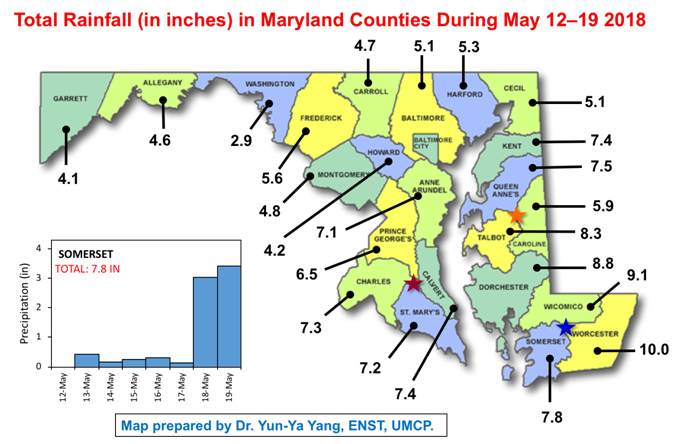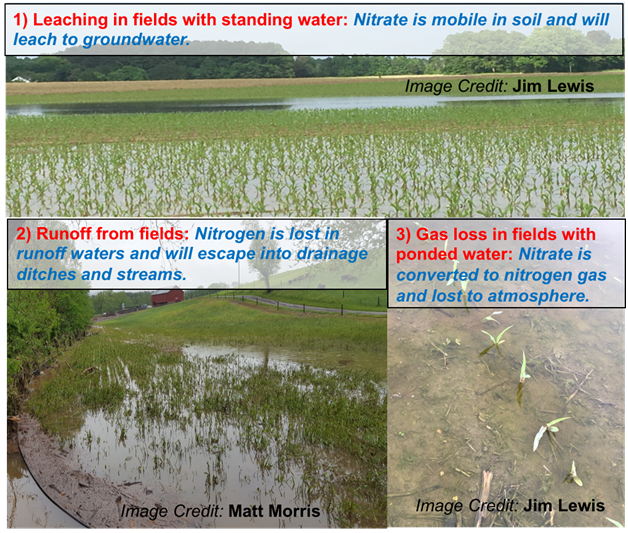
By Dr. Gurpal Toor, Associate Professor of Nutrient Management and Water Quality; and Dr. Bob Kratochvil, Extension Agronomist
University of Maryland, College Park
INTRODUCTION: The last few days have kept many of us indoors at the expense of promise of springtime weather! However, there is nothing unusual in these weather patterns; rather this is another reminder about the uncertainty and unpredictability of weather. As the below map shows, in one week (May 12–19), various counties in Maryland received from 3 to 10 inches of rainfall. Several counties received several inches of rainfall in a day. This excess rainfall has not only affected the timely planting of corn but has the potential to affect the corn that is already planted. 
IMPACT: The biggest impact of this rain will be in the fields that received all nitrogen fertilizer prior to or at planting. This is a good time to revisit the implications of adding all nitrogen fertilizers at pre-plant and why applying all nitrogen in one-time application is NOT A GOOD IDEA. Plants are like us who need food in the form of nutrients several times a day. So, why do we apply all nitrogen fertilizer at pre-plant? It’s convenient for sure, but not the best farming decision in terms of plant needs. This is why University of Maryland Extension does not recommend applying all nitrogen fertilizers prior to or at planting. Consider that early in the season, corn needs ~1 pound of nitrogen per day per acre, which during later vegetative stages increases to ~3 pounds per day per acre. If you applied 200 pounds of nitrogen prior to or at planting, the corn may use only about 30 pounds in the first 30 days. You are hoping the rest of the nitrogen (200–30 =170 pounds) will remain in the soil for use by the plants later in the season. However, if weather is not favorable, like what occurred during May 12–19, some of this nitrogen will be lost via three ways, as shown below in the image.
There is no way to know how much nitrogen was lost from fields as this requires precise measurement because it will vary depending upon soil type, location, and amount of rainfall received. However, some general conclusions can be drawn that some nitrogen was lost via leaching, surface runoff, and gas loss. Consider that 1 inch of rain adds 27,154 gallons of water to an acre and weighs about 113 tons. This 1 inch of rain will penetrate 6 to 15 inches in soil (depending on soil texture). This rain water will flush (leach) the soluble and highly mobile nitrate form of nitrogen (most common form of nitrogen) deeper into the soil profile. Several inches of rain like we received in May will leach nitrate below the plant roots. Another way nitrate will be lost is via surface runoff from the fields. If that’s not enough, ponded water in the fields will convert nitrate to nitrogen gas, which will escape to the atmosphere.
RECOMMEDATIONS: As the saying goes “you can’t change the past” but you can take steps to minimize nitrogen losses in future years. First and foremost–do not apply all of nitrogen fertilizers prior to or at planting. This is because there is higher risk of nitrogen loss in spring as uptake of nitrogen by corn is minimal until approximately 35 days after emergence. At that point, corn enters into rapid growth phase and nitrogen uptake occurs. Thus, apply a small amount (~20–30 percent prior to or at planting) and add the remainder (~70–80 percent) as a sidedress when the corn is 10 to 20 inches tall. In the fields where all of nitrogen fertilizer was applied at pre-plant, consider doing a pre sidedress nitrate test (PSNT) to determine if there is a need to add more fertilizer. Contact Maryland Department of Agriculture to assure that this application will be in compliance with your nutrient management plans. Kudos to those farmers who only applied a part of nitrogen fertilizer at pre-plant and are planning to apply the remainder as sidedress; you saved yourself some fertilizer and money that otherwise would have been lost!
